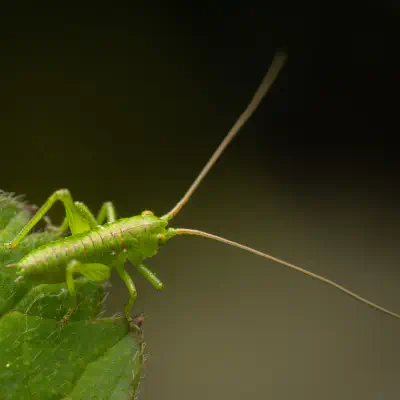Grasshoppers, Crickets, and Katydids Lat. “Orthoptera“
Orthoptera is an order of insects that comprises the grasshoppers, locusts and crickets, including closely related insects such as the katydids and wetas. The order is subdivided into two suborders: Caelifera – grasshoppers, locusts and close relatives; and Ensifera – crickets and close relatives.
Hierarchy
Etymology
The name is derived from the Greek ὀρθός orthos meaning “straight” and πτερόν pteron meaning “wing”.
Characteristics
Orthopterans have a generally cylindrical body, with elongated hindlegs and musculature adapted for jumping. They have mandibulate mouthparts for biting and chewing and large compound eyes, and may or may not have ocelli, depending on the species. The antennae have multiple joints and filiform type, and are of variable length. The first and third segments on the thorax are larger, while the second segment is much smaller. They have two pairs of wings, which are held overlapping the abdomen at rest. The forewings, or tegmina, are narrower than the hindwings and hardened at the base, while the hindwings are membranous, with straight veins and numerous cross-veins. At rest, the hindwings are held folded fan-like under the forewings. The final two to three segments of the abdomen are reduced, and have single-segmented cerci.
Life cycle
Orthopterans have a paurometabolous lifecycle or incomplete metamorphosis. The use of sound is generally crucial in courtship, and most species have distinct songs. Most grasshoppers lay their eggs in the ground or on vegetation. The eggs hatch and the young nymphs resemble adults, but lack wings and at this stage are often called ‘hoppers’. They may often also have a radically different coloration from the adults. Through successive moults, the nymphs develop wings until their final moult into a mature adult with fully developed wings. The number of moults varies between species; growth is also very variable and may take a few weeks to some months depending on food availability and weather conditions.
Evolution
This order evolved 300 million years ago with a division into two suborders – Caelifera and Ensifera – occurring 256 million years ago.
See also
List of Orthopteroid genera containing species recorded in Europe List of Orthoptera recorded in Britain Orthopterida Female sperm storage
External links
Orthoptera Species File Online Orthoptera Image Gallery (Iowa State University Entomology Department) Australian Plague Locust Commission The Orthopterists’ Society AcridAfrica, les acridiens d’Afrique de l’Ouest “Orthoptera” . New International Encyclopedia. 1905. Birdwing Grasshoppers in Belize Sound recordings of Orthoptera at BioAcoustica
Ancestry Graph
Further Information
„Grasshoppers, Crickets, and Katydids“ on wikipedia.org
„Grasshoppers, Crickets, and Katydids“ on iNaturalist.org
Copyright

This article uses material from the Wikipedia article Orthoptera the free encyclopedia Wikipedia which is released under Creative Commons Attribution-ShareAlike 4.0 International License). On Wikipedia a list of authors is available.

Little beings in print
Order our calendars and books today!
Compiled with love. Printed sustainably. Experience our little beings even more vividly in print. All our publications are available for a small donation.










